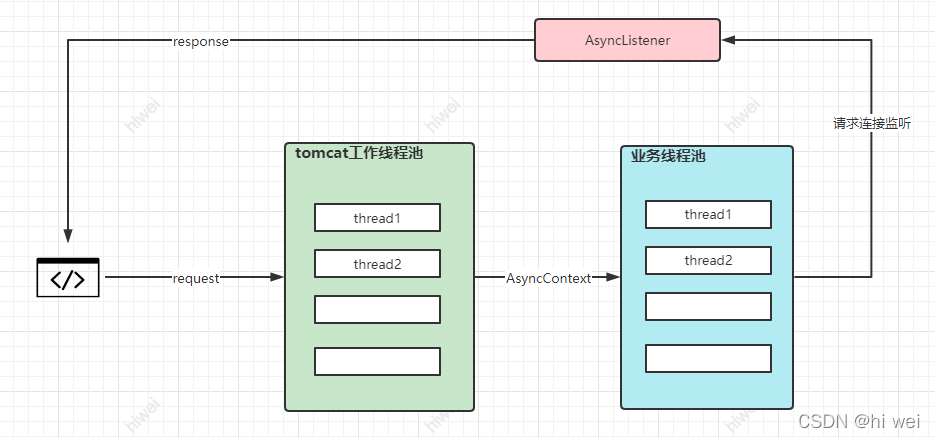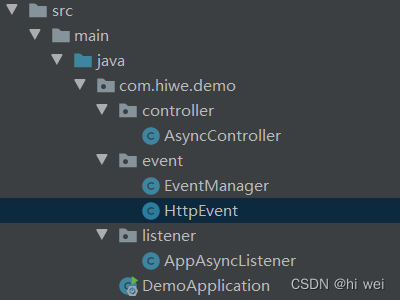Java 高性能长轮询
hi wei 人气:2servlet3.0的异步原理
servlet基础就不做介绍了,这里就介绍servlet3.0的一个重要的新特性:异步。
servlet3.0原理图:

- tomcat接收到客户端的请求后会将请求AsyncContext交给业务线程,这样tomcat工作线程就能释放出来处理其它请求的连接。
- 业务线程池接收到AsyncContext后,就可以处理请求业务,完成业务逻辑后,根据AsyncContext获取response,返回响应结果。
- AsyncListener会监听AsyncContext的行为,我们可以根据具体的行为做出对应的业务处理。
servlet3.0将tomcat工作线程和业务线程分隔开来,这样tomcat工作线程就能处理更多的连接请求。业务线程主要处理业务逻辑。在这种模式下,可以更好的分配业务线程的数量,也能根据不同的业务,设置不同的线程数量,更加灵活。
注意:tomcat的NIO和servlet3.0的异步没有关系。tomcat NIO模式,是对于http连接的处理使用,目的是用更少的线程处理更多的连接。servlet3.0是在tomcat工作线程的处理逻辑上实现异步处理功能。
使用servlet3.0实现长轮询
什么是长轮询:
- 长轮询是指客户端会一直向服务端发起请求,适用与服务端向客户端推送数据使用。长轮询要满足以下几点: 客户端发起请求后,当服务端业务没有数据时,不会立即返回空值,而是hold住连接,等待数据生成后立即返回。
- 请求在服务端有超时时间,不会一直hold住。当超时后,服务端会返回超时信息,客户端收到返回后会再次发起请求。
- 每次请求结束后,客户端会再次发起请求。
短轮询、长轮询和长连接比较:
- 短轮询:客户端定时向服务器发送Ajax请求,服务器接到请求后马上返回响应信息并关闭连接。
优点:后端程序编写比较容易,适于小型应用。。
缺点:请求中有大半是无用,浪费带宽和服务器资源。
- 长轮询:客户端向服务器发送Ajax请求,服务器接到请求后hold住连接,直到有新消息才返回响应信息并关闭连接,客户端处理完响应信息后再向服务器发送新的请求。
优点:在无消息的情况下不会频繁的请求。
缺点:服务器hold连接会消耗资源。
- 长连接:客户端与服务端建立长连接socket
优点:可靠性高,实时性高。
缺点:实现复杂,要维护心跳,服务器维持连接消耗资源。
长轮询实现
原理图:

- 请求过来之后,生成事件,加入对应的事件集合。请求设置30s超时时间,并添加监听。tomcat工作线程释放。
- 当服务端数据准备好之后,触发对应事件,从容器获取订阅事件进行执行。完成后返回response。
- 请求超时,listener触发,返回超时信息。
下面看下具体实现:

事件定义,这里只是定义一个简单的事件:
package com.hiwe.demo.event;
import javax.servlet.AsyncContext;
public class HttpEvent {
/**
* 可以是业务数据主键,这里用请求名称做个简单demo
*/
private String requestName;
private AsyncContext asyncContext;
public HttpEvent(String requestName,AsyncContext asyncContext){
this.requestName = requestName;
this.asyncContext = asyncContext;
}
public String getRequestName() {
return requestName;
}
public AsyncContext getAsyncContext() {
return asyncContext;
}
}
事件管理器:
package com.hiwe.demo.event;
import javax.servlet.AsyncContext;
import java.io.IOException;
import java.io.PrintWriter;
import java.util.HashMap;
import java.util.Map;
public class EventManager {
private final static Map<String,HttpEvent> subHttpEvents = new HashMap<>();
/**
* 新增事件订阅
* @param event
*/
public static void addHttpEvent(HttpEvent event){
subHttpEvents.put(event.getRequestName(),event);
}
/**
* 触发事件
* @param requestName
*/
public static void onEvent(String requestName){
HttpEvent httpEvent = subHttpEvents.get(requestName);
if(httpEvent==null){
return;
}
AsyncContext asyncContext = httpEvent.getAsyncContext();
try {
PrintWriter writer = asyncContext.getResponse().getWriter();
writer.print(requestName+" request success!");
writer.flush();
asyncContext.complete();
subHttpEvents.remove(requestName);
} catch (IOException e) {
e.printStackTrace();
}
}
}
异步请求监听器:
package com.hiwe.demo.listener;
import javax.servlet.AsyncContext;
import javax.servlet.AsyncEvent;
import javax.servlet.AsyncListener;
import javax.servlet.ServletResponse;
import javax.servlet.annotation.WebListener;
import java.io.IOException;
import java.io.PrintWriter;
@WebListener
public class AppAsyncListener implements AsyncListener {
@Override
public void onComplete(AsyncEvent asyncEvent) throws IOException {
System.out.println("AppAsyncListener onComplete");
// we can do resource cleanup activity here
}
@Override
public void onError(AsyncEvent asyncEvent) throws IOException {
System.out.println("AppAsyncListener onError");
//we can return error response to client
}
@Override
public void onStartAsync(AsyncEvent asyncEvent) throws IOException {
System.out.println("AppAsyncListener onStartAsync");
//we can log the event here
}
/**
* 超时触发
* @param asyncEvent
* @throws IOException
*/
@Override
public void onTimeout(AsyncEvent asyncEvent) throws IOException {
AsyncContext asyncContext = asyncEvent.getAsyncContext();
ServletResponse response = asyncEvent.getAsyncContext().getResponse();
PrintWriter out = response.getWriter();
//返回code码,以便前端识别,并重建请求
out.write(201+" longPolling timeout");
out.flush();
asyncContext.complete();
}
}
长轮询接口:
package com.hiwe.demo.controller;
import com.hiwe.demo.listener.AppAsyncListener;
import com.hiwe.demo.event.EventManager;
import com.hiwe.demo.event.HttpEvent;
import org.springframework.web.bind.annotation.GetMapping;
import org.springframework.web.bind.annotation.RequestMapping;
import org.springframework.web.bind.annotation.RequestParam;
import org.springframework.web.bind.annotation.RestController;
import javax.servlet.AsyncContext;
import javax.servlet.http.HttpServletRequest;
import javax.servlet.http.HttpServletResponse;
@RestController
@RequestMapping("/app")
public class AsyncController {
/**
* 长轮询接口
* @param requestName
* @param request
* @param response
*/
@GetMapping("/asyncGet")
public void getDemo(@RequestParam(value = "requestName") String requestName, HttpServletRequest request, HttpServletResponse response){
//开启异步支持
request.setAttribute("org.apache.catalina.ASYNC_SUPPORTED", true);
AsyncContext asyncContext = request.startAsync();
//添加监听器
asyncContext.addListener(new AppAsyncListener());
//设置超时时间
asyncContext.setTimeout(30000);
//添加到事件集合中去
HttpEvent httpEvent = new HttpEvent(requestName, asyncContext);
EventManager.addHttpEvent(httpEvent);
}
/**
* 触发事件使用
* @param requestName
*/
@GetMapping("/trigger")
public void triggerDemo(@RequestParam(value = "requestName") String requestName){
EventManager.onEvent(requestName);
}
}
以上一个简单的长轮询就实现了,我们可以进行一下测试:
启动应用后访问:http://localhost:8080/app/asyncGet?requestName=123
服务端因为数据未准备就绪,所以会hold住请求。当等待30s后会返回超时信息:

我们在30s内触发event:http://localhost:8080/app/trigger?requestName=123
返回:

以上整个长轮询实现完成了,如果有错误,欢迎指正!
加载全部内容